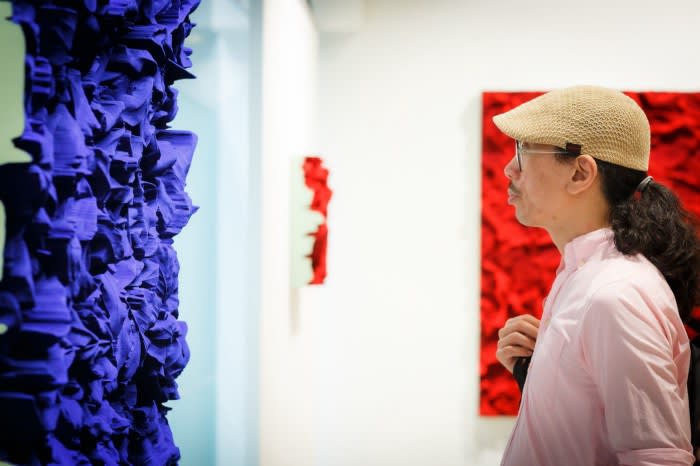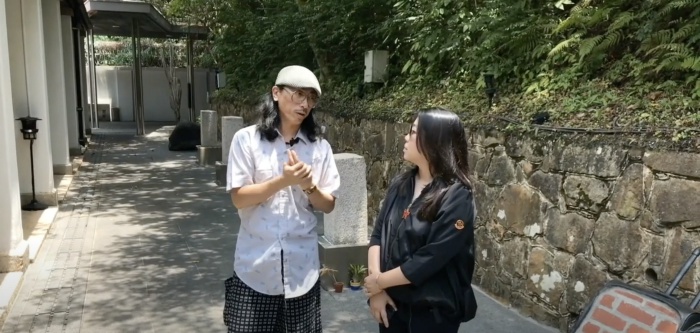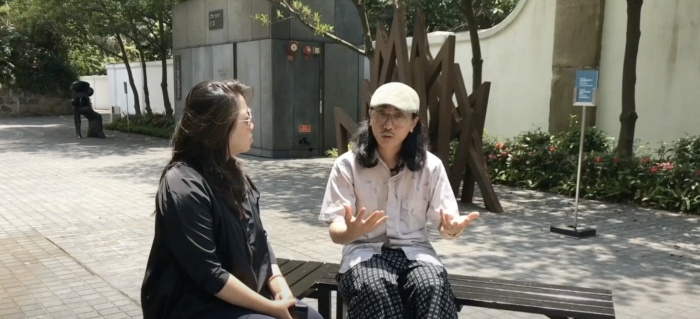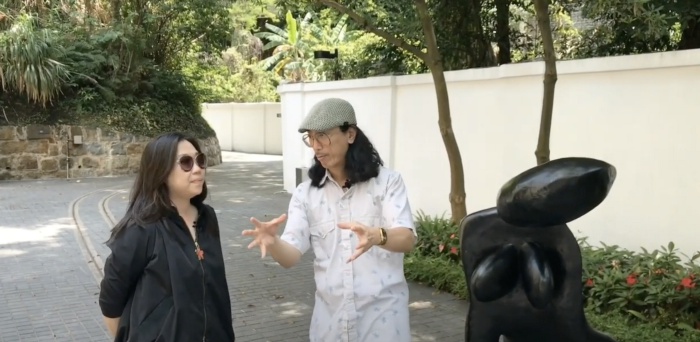
THIS WEEK, ORA-ORA SPEAKS WITH CURATOR JEFF LEUNG ON THE CHANGING ART ECOSYSTEM AND HIS INSIGHT ON THE FUTURE OF EXHIBITION PLANING AND CURATING IN HONG KONG.
Dr. Henrietta Tsui-Leung as Henri
Jeff Leung as Jeff
Henri: Jeff, I know that you have experience in curating. A lot of my friends or recent university graduates also voiced out their dreams of becoming a curator. Some sent in job applications to our gallery and some asked about the career pathways for curators. I know you graduated from Chinese University of Hong Kong. Can you share with us your experience growing up and learning art?
Jeff: Just like a lot of local artists here in Hong Kong, I studied Fine Art in the Chinese University of Hong Kong. I focused more on Creative Design then. After I graduated, I fell into curating work by chance. I first started learning more about the operations of an exhibition, and slowly began focusing on curating. Because my roots are in creative design, aside from curating exhibitions, I also love visiting exhibitions.
I am happy to join you in this interview today not only because I enjoy talking to you, but also because I wanted to admire some of the exhibits here. You can look at this exhibit for example. Every time I look at different exhibits, I would ask the artists or specialists and enquire more details about the artwork and ask for their opinions on it. I would also try to understand the artwork from the viewers’ perspective. I do a lot of data collection which benefits my decision-making process for the future exhibitions I manage and curate.
After I graduated, I worked at various art organisations, including Para Site Art Space, a non-profit organisation, and commercial art galleries, and Hong Kong Art Centre. Aside from managing my own exhibitions, I also provide assistance and support to my teams and superiors to achieve their curatorial intents. Aside from doing my own curatorial works, I also help other people achieve their goals. I like to use making movies as an analogy. I am like a director, I have an artistic vision and will incorporate that vision into my work. As a director, I also have an operational know-how, I need to cooperate with the editor and executive teams to devise strategies to execute my movie. This is my specialty. Directors also do not only make movies for themselves, they also do so for studios and companies. As a curator, I also do executive work, where I take on the role of executing ideas.
Henri: Sometimes, the organisations have some artistic ideas they would want you to help to achieve.
Jeff: Exactly. I am lucky to have taken on different roles which have allowed me to understand how to run an exhibition. The way I give advice may be different from the way the younger generation does it. It is about how to creatively find the best artists to visualise a certain idea. I am lucky enough to have been able to do both things.

Henri: While preparing for the interview, I talked to you about my interest in your background. I was curious why you came to be so interested in curation. You said that you are not only a curator, you are also a researcher. You have a lot of ongoing passion projects. Let’s talk about that. Firstly, let’s talk about your research on artist-led art spaces. You began your career in Para Site. It was founded by different local artists. I would like to hear your thoughts about this.
Jeff: Creators’ interests usually stem from their personal experience. As I said earlier, after I graduated, I began working at Para Site Art Space where I planned and executed exhibitions. Back then, we called these art spaces that are single-handedly managed by the artists themselves “artist-run art spaces”. Nowadays, they are called “self-managed organisations”. Having had experience running those kinds of exhibitions, I developed an interest in these art spaces.
While studying art, I gained knowledge about Hong Kong’s art history. During the mid 1980s and 1990s, some artists found that traditional art spaces did not sufficiently allow them to carry out their own artistic intentions. They needed art spaces that were evolvable. White Cube-style exhibition venues are not enough for them. They tried to find other art venues. Organisations also rented spaces for their own exhibitions. Around 1996, the Hong Kong Arts Development Council provided funding to artists which allowed them to experiment with other art venues. Para Site was formed in 1996 and I joined the Para Site team in 2001. I gained knowledge about art spaces while working there and also explored other spaces during my spare time.
Henri: In 2003, you were involved in preparing for the Hong Kong Pavilion at the Venice Biennale. What did you do?
Jeff: The Hong Kong Arts Development Council was responsible for organising and managing the team. They issued public invitations where individuals, art organisations, and artists could submit their own proposals. In 2003, Para Site submitted the proposal and succeeded. I was therefore participating in the project as part of the Para Site’s artistic team. Other than brainstorming ideas, I was also responsible for the operations of the project and helped in realising and visualising the team’s ideas.
Henri: I noticed that you enjoyed going to exhibitions and doing research. Is there anything you could share with us about this?
Jeff: The Chinese University of Hong Kong is famous for its student-led exhibitions within the Arts Faculty. As CUHK art students, we were exposed to the idea of exhibitions at an early age. While we were exposed to it, I was still unfamiliar with the concept and decided to take the initiative to learn more about it on my own.
While I was still a student, I enjoyed looking at other students’ exhibitions. After I graduated, I kept visiting exhibitions in universities. Hong Kong has nine universities that offer courses relating to art and design. What I observed is that the style of the graduates’ works very much correspond with the teaching methods of their respective schools. For example, if students graduated from City University’s Creative Multimedia department, you would know their works would have something to do with multi-media or digital media. If you graduated from Hong Kong Art School or Chinese University’s Fine Arts department, your work tends to be more classical and traditional. Learning environments have a lot to do with one’s artistic and stylistic development.
As time goes by, the mode of graduate exhibitions have evolved. The students themselves wanted their exhibitions to be unique and stand out from the past years. There are a lot of structural changes. There are some minor changes that most people don’t even notice. After 2000, there was a trend where students put their name cards next to their own exhibitions. We rarely see that nowadays. There are a lot of reasons to this, which I won’t delve into for now. In the last 5–7 years, the art industry has flourished. Art galleries have provided support to these student graduate exhibitions by sponsoring awards. At the same time, student artists wanted more variety and would make their own awards.

Jeff: Choosing artists for an exhibition is similar to having a meal. A balanced diet is important. Famous artists make marketing easier, young artists provide a breath of fresh air, experienced artists guarantee quality. Just like meals with fish, vegetables and meat, you need variety. You can change the proportions based on the situation which could potentially lead to great results.
Henri: What advice can you give to arts students?
Jeff: Even before the pandemic, the local art scene was undergoing a paradigm shift. For example, as I mentioned earlier, art spaces have slowly evolved from being exhibition space-oriented to become project space-oriented within the last 10 years. Art spaces no longer only consider financial gain and operation costs. They became more open to co-work spaces where different kinds of exhibitions can be incorporated there. Given that land rent is high in Hong Kong, it should be noted that that a change of environment is a given every 3 to 5 years.
Henri: There is no permanence. There is more flexibility.
Jeff: There is basically no sense of permanence. As investment bankers like to say, you have to have exit plans, where you have to prepare to leave and find new models anytime. A clear example will small spaces like 100ft PARK. They have exit plans and are not here for the long-run. This is one paradigm shift. Another change I noticed in the art scene, which is prompted by the pandemic, is that the new generation’s artists need to be able to use two different channels to promote their work. This is a very typical Hong Kong mindset. Artists now have two different ways of thinking — commercial sense and artistic vision. They are also skilled in communicating using both creative and presentational language, and in the ability to talk to an audience.
The world has become more and more technologically advanced. I noticed that there is a lot of fragmentation between communities. Upon graduation, students can work for art galleries on fine art projects, they can also work on community art projects. Both works involve aesthetics, but the communities involved are different. As a result, you need to utilise different languages in order to present and communicate with different communities. The creative industry needs to have a start-up mindset. If your idea is innovative and difficult for people to understand, you have to find the right channel and language to present your ideas and to find suitable collaborators. I think that there will be surge of smaller-scale co-working and collaborating work in the coming years among the younger generation of artists. This kind of collaboration has been more common among the creative media circle previously, but I feel like it will find its way to art galleries and community art projects. There will be a start-up element to it. The new creative innovation development will be a mix of commerce and culture.

Jeff: The art market in Hong Kong is different than that of Europe’s. Europe has more flexibility in promoting media arts. The current pandemic allows the Hong Kong art industry to experiment more on media art and digital art, although I’m not certain it can flourish in Hong Kong. Hong Kong has been focusing more on substantive artwork, but now there is time to take a break and experiment with going online and making digital art. After the pandemic, we can consider whether we can combine online artwork with substantive artwork. I am currently asking other people for advice on how to operate a virtual museum and how to utilise digital art in this new landscape. This is what I’m thinking of nowadays. I wouldn’t say there is anything good or bad about the effect the pandemic has on the art industry. What I learnt from other artists is that we can always have creative reactions in any given situation.
ABOUT ORA-ORA LIVE
Each week, Ora-Ora will speak with various members of the art community — including artists, curators, academics and other professionals working in the cultural sector — to address topics of interest related but not limited to Hong Kong’s art and cultural scene. The series aims to be an outlet for creativity and a means to connect with peers who share similar interests. The episodes will also available live on Ora-Ora’s Instagram (@galerieoraora), Facebook (Galerie Ora-Ora) and later on Ora-Ora’s YouTube channel.